CHEVROLET ASTRO 2003 Repair Manual
Manufacturer: CHEVROLET, Model Year: 2003, Model line: ASTRO, Model: CHEVROLET ASTRO 2003Pages: 386, PDF Size: 17.31 MB
Page 61 of 386
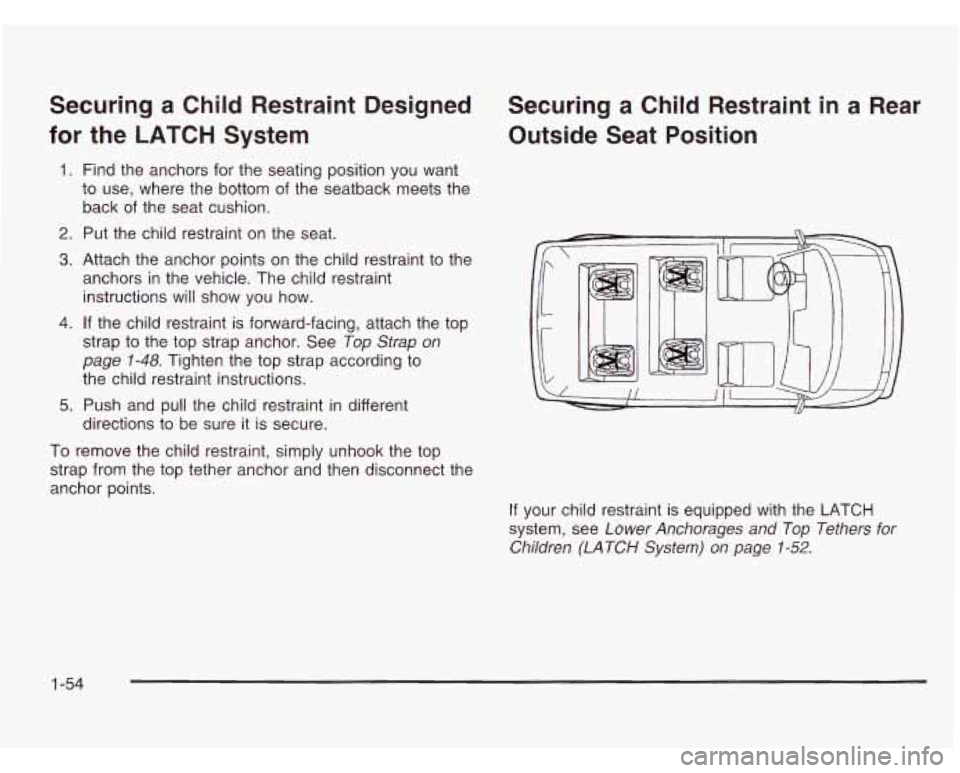
Securing a Child Restraint Designed Securing a Child Restraint in a Rear
for the
LATCH System
Outside Seat Position
1. Find the anchors for the seating position you want
to use, where the bottom of the seatback meets the
back
of the seat cushion.
2. Put the child restraint on the seat.
3. Attach the anchor points on the child restraint to the
anchors in the vehicle. The child restraint
instructions will show you how.
4. If the child restraint is forward-facing, attach the top
strap to the top strap anchor. See
Top Strap on
page
7-48. Tighten the top strap according to
the child restraint instructions.
directions to be sure it is secure.
5.
Push and pull the child restraint in different
To remove the child restraint, simply unhook the top
strap from the top tether anchor and then disconnect the
anchor points.
If your child restraint is equipped with the LATCH
system, see Lower Anchorages and Top Tethers for
Children (LATCH System) on page
1-52.
1-54
Page 62 of 386
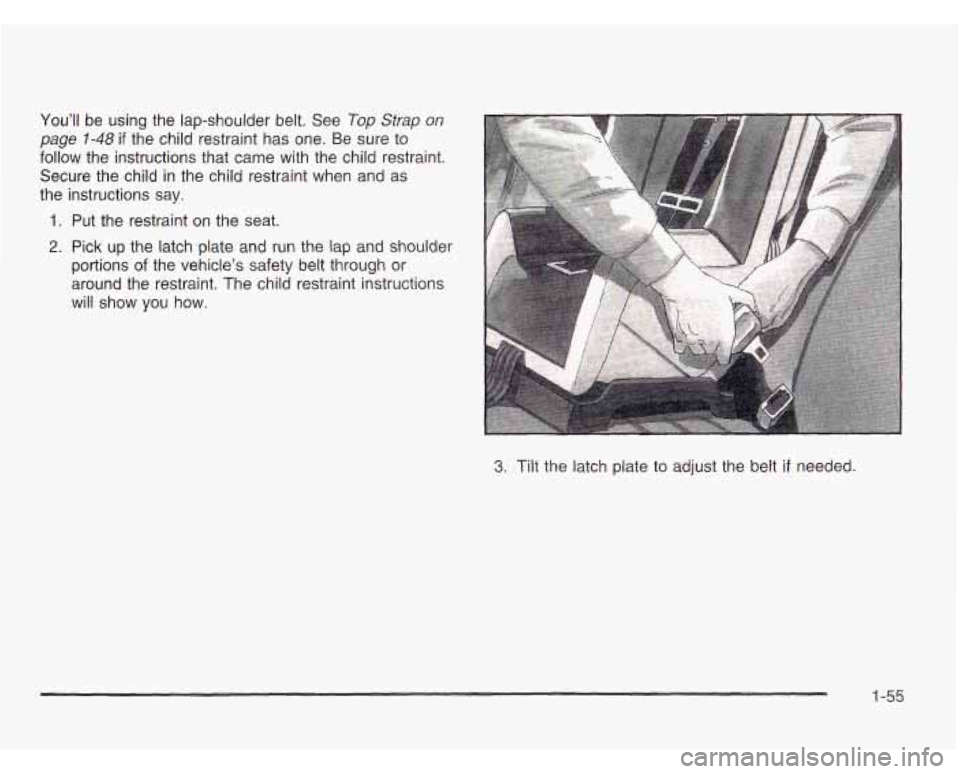
You’ll be using the lap-shoulder belt. See Top Strap on
page 1-48 if the child restraint has one. Be sure to
follow the instructions that came with the child restraint.
Secure the child in the child restraint when and as
the instructions say.
1. Put the restraint on the seat.
2. Pick up the latch plate and run the lap and shoulder
portions
of the vehicle’s safety belt through or
around the restraint. The child restraint instructions
will show you how.
3. Tilt the latch plate to adjust the belt if needed.
1-55
Page 63 of 386
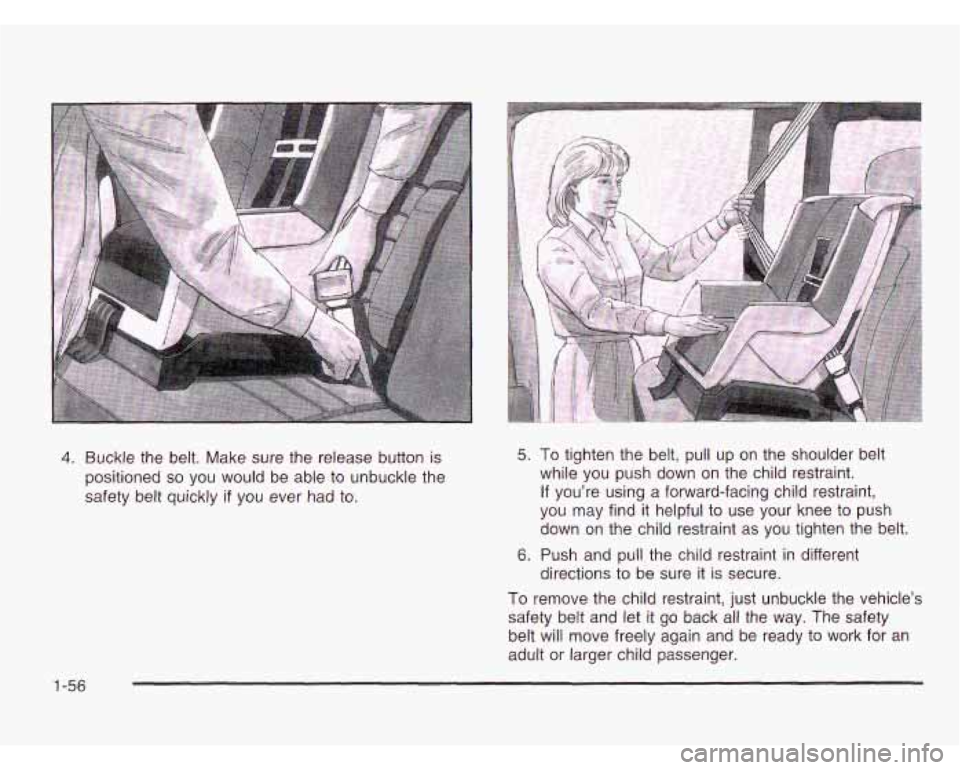
4. Buckle the belt. Make sure the release button is
positioned
so you would be able to unbuckle the
safety belt quickly
if you ever had to.
5.
6.
To tighten the belt, pull up on the shoulder belt
while you push down
on the child restraint.
If you’re using a forward-facing child restraint,
you may find it helpful to use your knee to push
down
on the child restraint as you tighten the belt.
Push and pull the child restraint in different
directions to be sure it
is secure.
To remove the child restraint, just unbuckle the vehicle’s
safety belt and let
it go back all the way. The safety
belt will move freely again and be ready to work for an
adult
or larger child passenger.
1-56
Page 64 of 386

Securing a Child Restraint in a
Center Seat Position
Bench Seat
You’ll be using the lap belt. Be sure to follow the
instructions that came with the child restraint.
Secure the child in the child restraint when and as
the instructions say.
See Top Strap on page 1-48 if the child restraint has one.
If your child restraint is equipped with the LATCH
system, see Lower Anchorages and Top Tethers for
Children (LATCH System)
on page 1-52.
1. Make the belt as long as possible by tilting the latch
2. Put the restraint on the seat.
plate
and pulling it along the belt.
1-57
Page 65 of 386
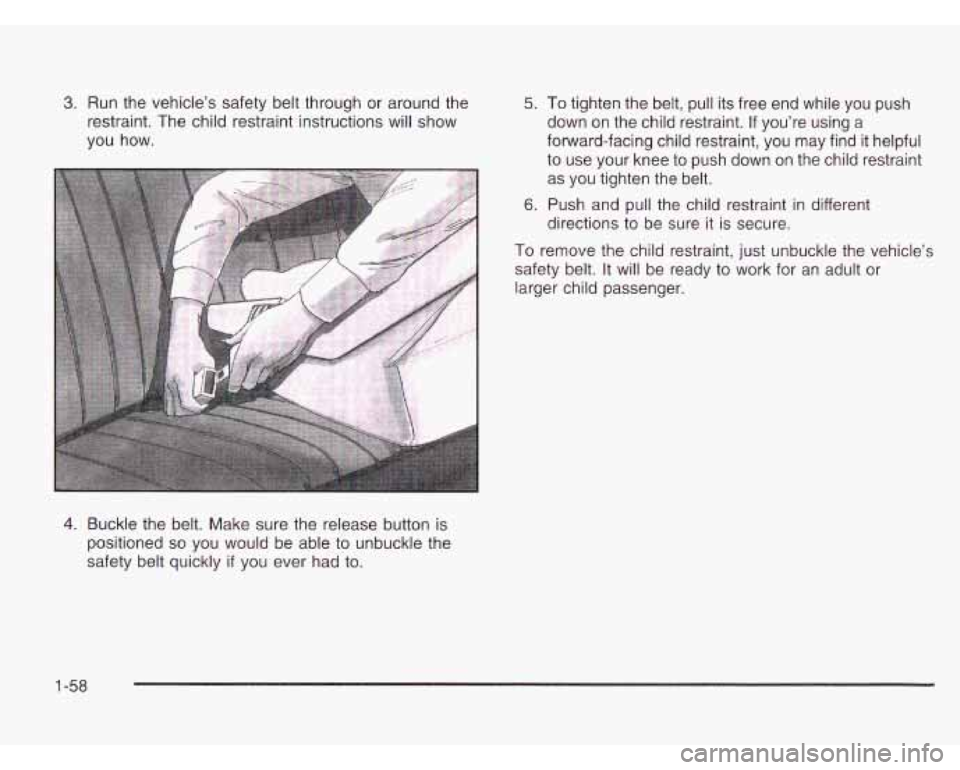
3. Run the vehicle’s safety belt through or around the
restraint. The child restraint instructions will show
you how. 5. To tighten the belt, pull its free end while you push
down on the child restraint. If you’re using a
forward-facing child restraint, you may find it helpful
to use your knee
to push down on the child restraint
as you tighten the belt.
directions
to be sure it is secure.
6. Push and pull the child restraint in different
To remove the child restraint, just unbuckle the vehicle’s
safety belt.
It will be ready to work for an adult or
larger child passenger.
4. Buckle the belt. Make sure the release button is
positioned
so you would be able to unbuckle the
safety belt quickly
if you ever had to.
1-58
Page 66 of 386
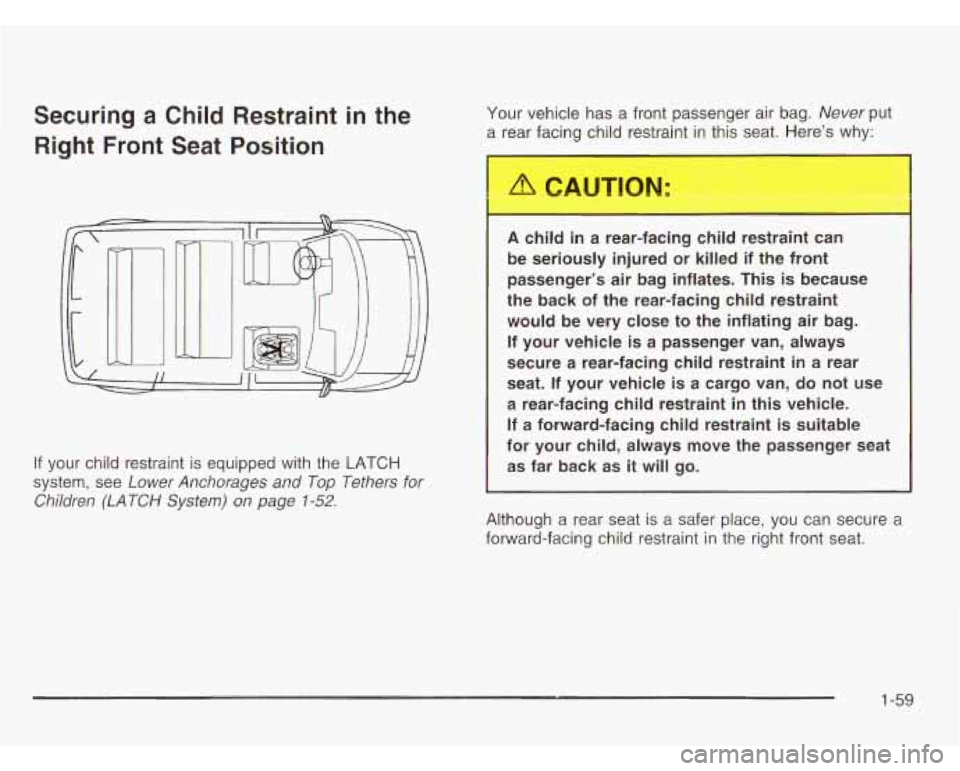
Securing a Child Restraint in the
Right
Front Seat Position
Your vehicle has a front passenger air bag. Never put
a rear facing child restr;
’ t in this seat. Here’s why:
.
If your child restraint is equipped with the LATCH
system, see
Lower Anchorages and Top Tethers for
Children (LATCH
System) on page 1-52.
A child in a rear-facing child restraint can
be seriously injured or killed
if the front
passenger’s air bag inflates. This
is because
the back of the rear-facing child restraint
would be very close
to the inflating air bag.
If your vehicle is a passenger van, always
secure a rear-facing child restraint
in a rear
seat. If your vehicle
is a cargo van, do not use
a rear-facing child restraint in
this vehicle.
If a forward-facing child restraint
is suitable
for your child, always move the passenger seat
as far back as
it will go.
L
Although a rear seat is a safer place, you can secure a
forward-facing child restraint in the right front seat.
1-59
Page 67 of 386
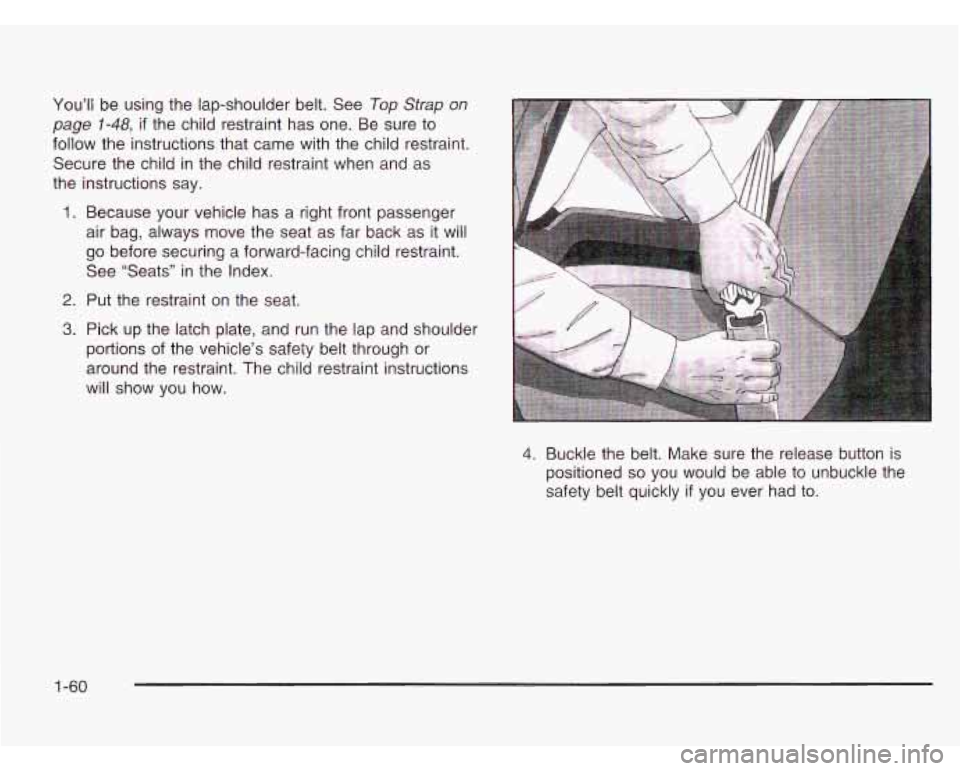
You’ll be using the lap-shoulder belt. See Top Strap on
page 1-48, if the child restraint has one. Be sure to
follow the instructions that came with the child restraint.
Secure the child in the child restraint when and as
the instructions say.
1. Because your vehicle has a right front passenger
air bag, always move the seat as far back as it will
go before securing a forward-facing child restraint.
See “Seats” in the Index.
2. Put the restraint on the seat.
3. Pick up the latch plate, and run the lap and shoulder
portions of the vehicle’s safely belt through or
around the restraint. The child restraint instructions
will show you how.
..
4. Buckle the belt. Make sure the release button is
positioned
so you would be able to unbuckle the
safety belt quickly
if you ever had to.
1-60
Page 68 of 386
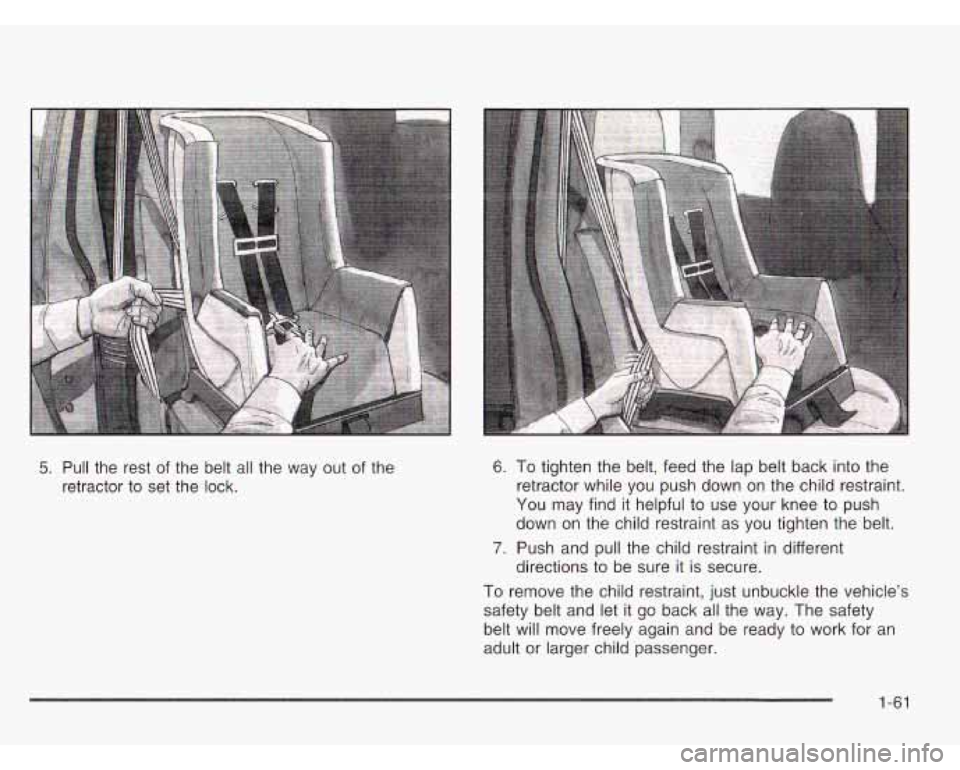
Page 69 of 386
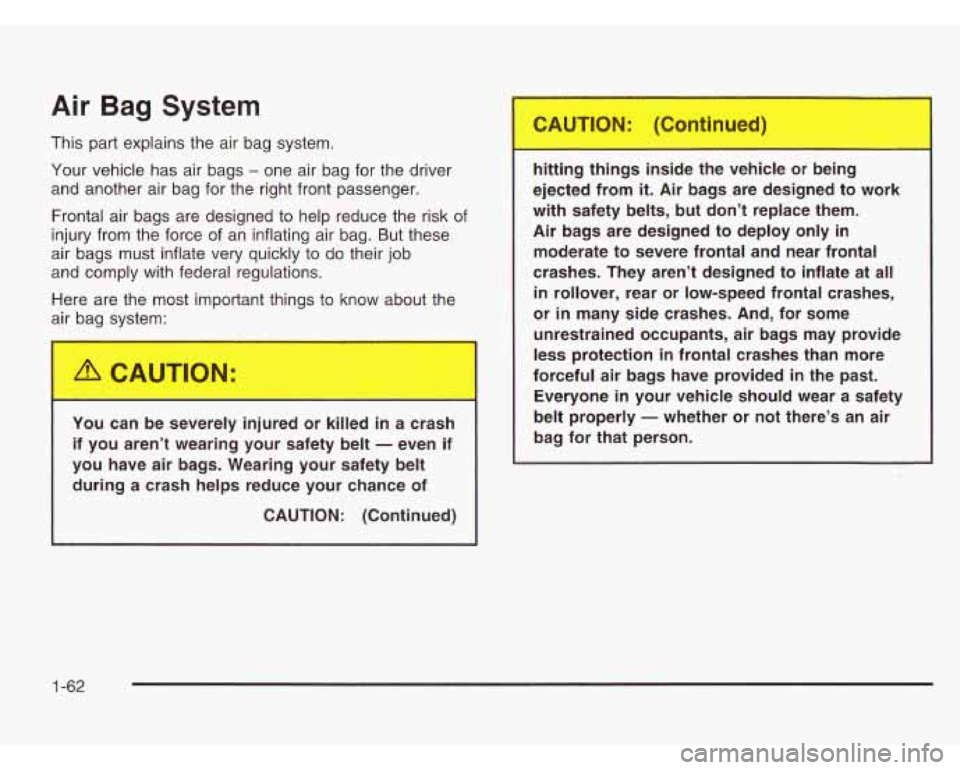
Air Bag System
This part explains the air bag system.
Your vehicle has air bags - one air bag for the driver
and another air bag for the right front passenger.
Frontal air bags are designed to help reduce the risk of
injury from the force of an inflating air bag. But these
air bags must inflate very quickly to do their job
and comply with federal regulations.
Here are the most important things to know about the
air bag system:
You ca.. Je severely injured or kiL- ..I a crash
if you aren’t wearing your safety belt
- even if
you have air bags. Wearing your safety belt
during a crash helps reduce your chance of
CAUTION: (Continued)
LI.cLI..g things inside the vehicle or being
ejected from
it. Air bags are designed to work
with safety belts, but don’t replace them.
Air bags are designed to deploy only in moderate to severe frontal and near frontal
crashes. They aren’t designed to inflate at all
in rollover, rear or low-speed frontal crashes,
or
in many side crashes. And, for some
unrestrained occupants, air bags may provide
less protection in frontal crashes than more
forceful air bags have provided in the past. Everyone
in your vehicle should wear a safety
belt properly
- whether or not there’s an air
bag for that person.
1-62
Page 70 of 386

All bags ,,,,late with ,;eat force, faster rllan
the blink of
an eye. If you’re too close to an
inflating air bag, as you would be if you were
leaning forward,
it could seriously injure you.
Safety belts help keep you
in position before
and during a crash. Always wear your safety
belt, even with air bags. The driver should sit
as far back as possible while
still maintaining
control of the vehicle. Anl,,le
who is up against, or very close
.a,
any air bag when it inflates can be seriously
injured or killed.
Air bags plus lap-shoulder
belts offer the best protection for adults, but
not for young children and infants. Neither the
vehicle’s safety belt system nor its air bag
system is designed for them. Young children
and infants need the protection that a child
restraint system can provide. Always secure
children properly in your vehicle. To read how,
see the parts of this manual called “Older
Children” and “Infants and Young Children.”
1-63